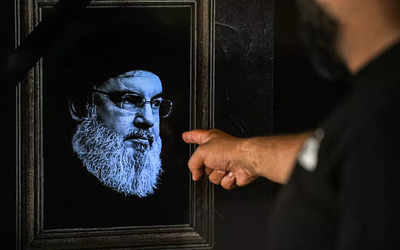
Hezbollah chief Sayyed Hassan Nasrallah, one of the world’s most feared terror leaders and the figure who had loomed large over Lebanon for decades, was killed in an Israeli airstrike after intelligence reportedly tipped off Israeli forces just hours before the attack.
The chilling operation, which took place in the dense southern suburbs of Beirut, was a direct result of a covert tip-off from an Iranian mole embedded deep within Hezbollah’s ranks, according to a report.
As per Le Parisien, the intelligence was precise, leaving Israel with a rare opportunity to eliminate the man at the top of the Shiite militant group.
As per the report, the tip from the mole arrived in the afternoon, alerting Israeli authorities that Nasrallah would be at Hezbollah’s fortified underground headquarters in Dahieh, a complex of six heavily guarded buildings hidden in plain sight in southern Beirut.
The Israeli Defense Forces (IDF) acted swiftly, preparing their F-35 jets, armed with bunker-busting bombs, to strike at the moment Nasrallah stepped foot in the compound.
The mission was high-risk but meticulously planned. “The Israelis went all out; they didn’t want to miss their target,” said a well-informed Lebanese security source, speaking under anonymity in the aftermath of the attack. For Israel, this was a rare chance to take down a man who had evaded them for over three decades.
Hassan Nasrallah & Hezbollah | 60 Minutes Archive
Nasrallah had been at the center of Hezbollah’s operations since the 1990s, a time when the group grew in influence, becoming a proxy force for Iran in the ongoing struggle against Israel. His underground command center, believed to be impenetrable, had long been a target. This time, however, Israel had the advantage — the mole’s information was solid, and the timing was perfect.
At the same moment as Nasrallah’s arrival, just a few kilometers away in the Haret Hreik neighborhood, a funeral was taking place for Mohamed Hussein Srour, the commander of Hezbollah’s drone unit, who had been killed in an Israeli strike the day before. The atmosphere was tense, with mourners unaware that their leader, Nasrallah, was also marked for death.
Then, just after 1:30 pm IST (11:00 am in Lebanon), the skies over Dahieh exploded. Israeli jets, hovering just outside the city’s airspace, launched their attack. The bunker-busting bombs penetrated deep into the complex, hitting their mark. Minutes later, smoke billowed from the ruins of Hezbollah’s fortified headquarters.
Nasrallah, the man who had vowed to destroy Israel, was dead.
In a swift statement posted on X (formerly Twitter), the IDF declared: “Hassan Nasrallah will no longer be able to terrorize the world.” Hours later, Hezbollah confirmed the devastating blow, issuing a statement: “Sayyed Hassan Nasrallah… has joined his great, immortal martyr comrades whom he led for about 30 years.”
But Nasrallah wasn’t the only casualty. Nabil Kaouk, another senior Hezbollah commander, was also killed in a separate Israeli airstrike, continuing a relentless campaign that has targeted key figures within the organization in recent days. Although Hezbollah remained silent on Kaouk’s death, supporters took to social media, posting mourning messages and tributes.
The airstrikes come amid a period of heightened conflict between Hezbollah and Israel, which has led to heavy casualties on both sides.
Lebanon’s health ministry reported that 33 people were killed in Israeli strikes on Saturday alone. Over the past two weeks, more than 1,000 have died, and at least 6,000 have been injured, though the breakdown of civilian versus combatant casualties remains unclear.
For Hezbollah, Nasrallah’s death represents an unprecedented loss.
In a recent televised address, Nasrallah himself acknowledged the group had suffered a severe blow after Israeli forces intercepted their communications and launched a devastating series of attacks using explosive-rigged devices.
The devices, including booby-trapped pagers and walkie-talkies, had killed 37 Hezbollah members and injured thousands more. “Unprecedented,” Nasrallah had admitted, yet defiant in his vow to retaliate. Hezbollah, he warned, would deliver “tough retribution and just punishment, both in expected and unexpected ways.”
As Lebanese authorities comb through the rubble and the details of the mole’s involvement begin to surface, the full scale of Israel’s intelligence victory becomes clearer. The airstrike that ended Nasrallah’s life marks a critical moment in the decades-long struggle between Israel and Hezbollah, and it raises the stakes for what comes next. With Hezbollah’s leadership in disarray, and their forces vowing revenge, the region waits anxiously for the inevitable fallout.





